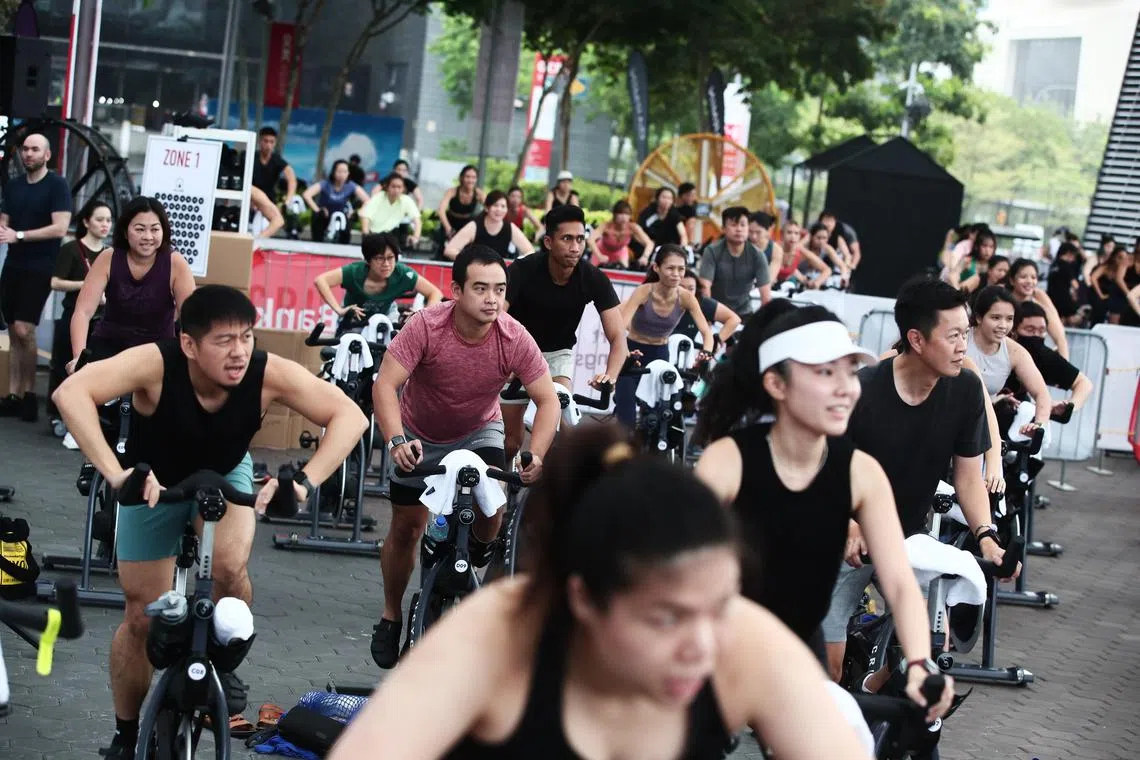From aerobics to hot yoga: Ways to raise tolerance for warmer weather
Sign up now: Get ST's newsletters delivered to your inbox

Aerobic exercises can help people adapt to heat by lowering their bodies’ core temperature and triggering earlier and faster sweating.
ST PHOTO: KELVIN CHNG
Follow topic:
SINGAPORE – Exercise is not only key to good health but also to heat-proofing oneself against rising temperatures.
In particular, aerobic exercises such as running, cycling and skipping rope can help people adapt to heat by lowering their bodies’ core temperature and triggering earlier and faster sweating to help the skin cool down.
Such cardio workouts also lower the heart rate, allowing the body to function more efficiently, said associate consultant Joshua Li from Changi General Hospital’s department of sport and exercise medicine.
Simply Science finds out how people can use cardio as a weapon to fight the heat.
Heat acclimatisation helps to reduce the risk of heat injury
Construction workers, soldiers and marathon runners are not unfamiliar with the concept of acclimatising to warmer conditions. In Singapore, new construction workers – especially those hailing from colder climates – and those returning from prolonged leave must undergo a two-week heat acclimatisation programme.
This involves gradually exposing employees to Singapore’s heat and humidity, and increasing the duration and intensity of work over the fortnight.
Scientists globally have been studying how ordinary people, especially the ageing population, can similarly build up their resilience to rising temperatures and brace themselves for heatwaves.
Dr Li noted that people who live in Singapore have already adapted to the climate, and most are able to tolerate small increases in temperature. The question is whether they are heat-acclimatised to the type of outdoor work required of them under the scorching sun.
“Heat injuries, including death, may occur when there is a sudden and marked increase in temperature – for example, a heatwave,” he said.
The trick to acclimatising properly and safely is to start with a good level of fitness.
Associate Professor Jason Lee from the National University of Singapore’s Yong Loo Lin School of Medicine (NUS Medicine), said: “If one is unfit, the recommendation is to attain a certain level of fitness before embarking on heat acclimatisation. Being aerobically fit per se is a very effective measure to beat the heat.”
Individuals can start by exercising in cooler environments to build their baseline aerobic fitness. Then they can move to a hot environment and slowly increase their exercise duration and intensity over two to three weeks, added Prof Lee, who is also director of the Heat Resilience and Performance Centre at NUS Medicine.
Dr Li recommends increasing the intensity and duration of outdoor physical work by 20 per cent each day.
“Doing light or brief physical work in the heat will acclimatise the individual only to light, brief work. More strenuous or longer tasks require more acclimatisation,” he added.
Both experts stressed the need to rest well and cool off in between sessions.
People with chronic diseases such as diabetes and heart disease can also raise their aerobic fitness within their means after consulting their doctors. But they should stop or seek medical attention when they feel the effects of heat strain, giddiness or chest pain, among other issues.
Some treatments for chronic diseases, such as blood thinners, Alzheimer’s medications and some chemotherapy drugs, can hinder the body’s ability to lose heat and regulate core temperature.
“Doctors need to be mindful of these and perhaps consider refining and enhancing safe medication prescription guidelines,” said Prof Lee.
Beyond outdoor activities, immersing in an onsen or sauna, and sweating it out at a hot yoga session can help people acclimatise to heat as well if done correctly.
Prof Lee said: “The use of sauna and onsen or hot yoga can raise internal body temperature, which is a key criterion for an effective heat acclimatisation session.
“A hybrid approach can also be used – exercise in the heat for a while and then go into an onsen thereafter to maintain the raised body temperature.”
Sauna or onsen can also be suitable alternatives for the elderly and those who are immobile.
Like stamina, a person’s tolerance to heat can wear off after a period of sedentary behaviour. Dr Li said that after a month without exercise and heat exposure, acclimatisation will be lost and the person will need to restart the two-week regime.
Someone who is adapted to higher temperatures will have better blood flow to the skin to facilitate heat loss and an increased sweat rate, among other benefits. But in Singapore’s highly humid environment, sweating more may not be a good thing because lingering moisture in the air makes it harder for perspiration to evaporate.
Noting that this is an area that needs further study here, Prof Lee said: “Sweating itself doesn’t lose heat. Sweat evaporation does... Increased sweating without helping to lose body heat can accelerate dehydration unnecessarily.”
Simply Science is a new fortnightly series looking at the science behind everyday questions.


